Apple WWDC23 Aspect Summary: Say goodbye to traditional computers? Vision Pro ushers in the era of “spatial computing”

[ad_1]
In the early morning of June 6, 2023, Beijing time, Apple held a grand WWDC23 conference at Apple Park in Cupertino, California. Different from the past, the focus of this conference is no longer the update of iOS, macOS and other systems. We have ushered in the most important new hardware product since Apple released the iPhone 16 years ago-Vision Pro.
With the launch of Apple’s Vision Pro headset, a new term “spatial computing” has also emerged. If the iPhone has opened the real era of mobile Internet, then Apple obviously hopes that Vision Pro will open the next era of technology.
In addition to Vision Pro, an epoch-making product, WWDC23 also has hardware product releases that developers and creators are looking forward to, including the 15.3-inch MacBook Air, the Mac Studio with the M2 chip, and the Mac Pro with the M2 Ultra chip, which is farewell to the Intel chip. officially unveiled.
In addition to hardware products, iOS 17, iPadOS 17, and macOS 14 are also coming as scheduled, but judging from the updated content, they seem relatively conservative and there are not many bright spots.
Replace the iPhone? Say goodbye to traditional PCs! Vision Pro ushers in the era of “spatial computing”
At first glance at Vision Pro, you can find many design elements of Apple’s wearable devices. To make an inappropriate analogy, Vision Pro looks like an elongated and deformed Apple Watch from the side. It uses a similar aluminum alloy shell and an external mirror. It is also made of glass, some knobs and buttons are similar to the crown of Apple Watch, and the mesh structure of other parts reminds people of Airpods Max. Subjectively speaking, this shape is not beautiful, but it is very similar to Apple’s design style in recent years.
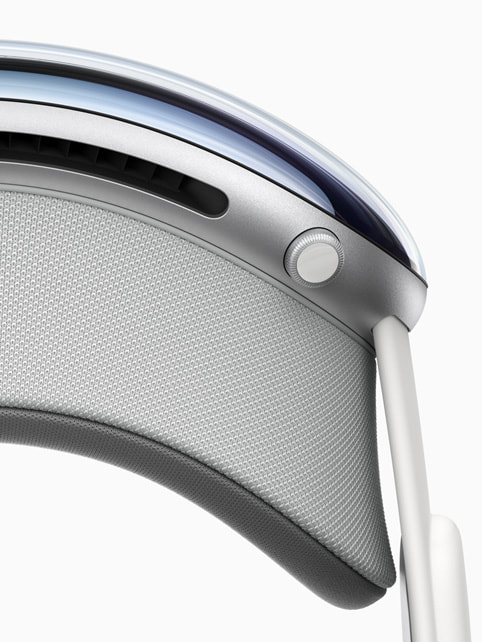
Although the appearance of the Vision Pro headset is larger than expected, when you see its hardware configuration, you will be surprised that it can be so bulky.
Vision Pro uses a custom micro OLED screen. The two screens can provide 23 million pixels of ultra-high resolution, with wide color gamut and HDR. Users with vision correction needs can additionally insert Zeiss optical inserts to ensure visual fidelity and eyeball Tracking accuracy. The optical insert can be inserted, which can greatly improve the experience of users who wear glasses. Of course, it will cost extra money.
Vision Pro is equipped with M2 chip, which has powerful computing power. With this chip, it is connected to the built-in 12 lenses, 5 sensors and 6 microphones to process massive data in real time. In order to further reduce the delay, a brand new R1 chip is additionally configured, which can synchronize the image to the Vision Pro screen within 12 milliseconds. According to the official introduction, this speed is 8 times faster than the blink of an eye, so under normal circumstances you should almost feel it. Less than visual lag.
In addition to the amazing display effect, Vision Pro also integrates headphone function and supports a new spatial audio system, which can collect ambient sound and provide sound effects suitable for the current scene through algorithms. Immersive.
Vision Pro provides an amazing experience in the digital world, while also taking into account the user’s experience of communicating with the outside world. Equipped with EyeSight technology, when someone approaches the Vision Pro user, the device’s viewing area will become transparent. You can see the eyes of the user wearing Vision Pro, effectively ensuring the connection and communication between the user and the outside world.
Vision Pro is also equipped with a 3D camera. Press the button on the device to record the wonderful moments of the moment in the form of 3D images and spatial audio.
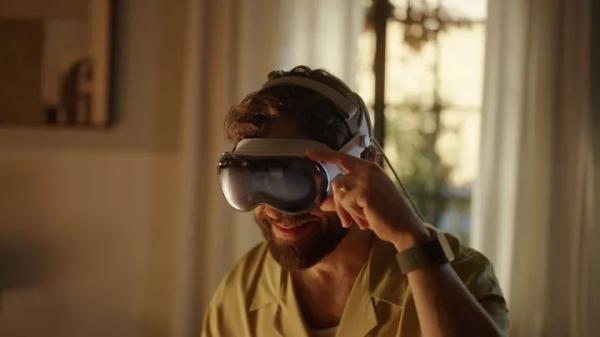
In terms of battery life, Vision Pro is mainly connected with a power cord. It provides an external mobile power supply that can support 2 hours of high-performance operation. The size and weight are acceptable. This power supply can be connected to the headset through magnetic attraction.
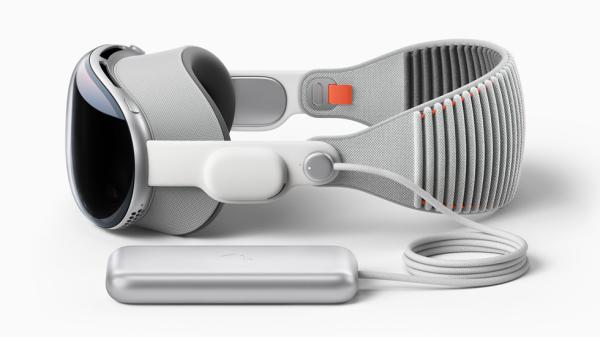
Vision Pro runs a brand-new operating system—visionOS, which is completely different from traditional keyboard, mouse, and touch operations. Users can control the system and apps through glasses, hands, and voice. In the promotional video, we can see users pinching their fingers to select, flick the wrist to scroll, and more. visionOS can natively support iPhone and iPad applications, and at the same time support Apple Arcade game content, which ensures that the Vision Pro software ecosystem can have a large amount of content for users to experience in the early stage.

Completely abandoning hardware and realizing the interaction between people and the digital world through somatosensory operation is also the biggest difference between Vision Pro and existing VR and AR devices in other industries, or an epoch-making feature. However, the author believes that if Vision Pro is to be compatible with more traditional application control methods in the early stage, it should also provide the function of Bluetooth connection to external devices such as keyboard and mouse. This can be seen from the demonstration part of Apple Arcade. Users can Use a controller to play the game.
There is too much information about Vision Pro, so here is a summary. In my opinion, if you think that the Vision Pro is to replace the iPhone, you are very wrong. Strictly speaking, it is not a real mobile device. It can run for 2 hours, and the size and weight also limit the application scenarios. Combined with the current technology, it is pessimistic to think that it will take at least ten years before the launch of Vision Pro devices that are more portable and affordable. But the Vision Pro has taken the first step toward replacing traditional PCs, and even Apple’s own Macs.
Judging from the demonstration effect, Vision Pro provides a more advanced interaction method than existing VR and AR devices. Basic operations do not require external handles, and only need gestures and voice. , Vision Pro brings a more human-intuitive interaction method, making digital content “at your fingertips”.
Although Vision Pro looks beautiful, at this stage, whether it can gradually replace traditional PCs and become a productivity tool in the new era will have to wait until it is officially released next year. Depending on the feedback from professional users, it will take time to build a visionOS native application ecosystem. .
The release of Vision Pro means that Apple has officially entered the fields of VR, AR, and MR. I believe that these fields will also usher in rapid development in the next few years. As ordinary users, we can witness the arrival of new computing platforms.
The Mac family adds a new member: the M2 chip Mac Pro is finally here
Compared with the Vision Pro, other hardware updates seem less attractive, but these devices are more closely related to the average user.
No longer compact, the 15.3-inch MacBook Air was born. If the performance of the MacBook Air equipped with the M chip is no longer Air, then after the release of the 15.3-inch MacBook Air, it is no longer Air in terms of volume. In addition to the larger screen, the hardware specifications are the same as the 13.6-inch MacBook Air. It is equipped with an M2 chip, with an 8-core CPU, a GPU with up to 10 cores, and a memory starting at 8GB, with a maximum optional 24GB.
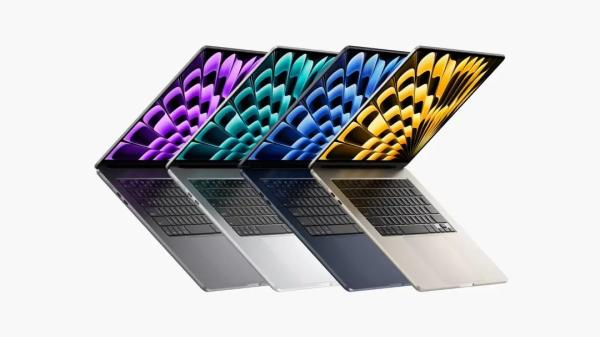
The M2 chip Mac Studio is released, and the performance continues to improve. M2 Max and M2 Ultra chips are optional. The memory supports up to 192GB, 24-core CPU and 76-core GPU, and the storage space supports up to 8TB. It has a more powerful HDMI interface, supports 8K resolution and 240 frames. For individual developers and creators, as well as small teams, Mac Studio is an excellent creative tool.

The long-awaited M-chip Mac Pro is here! Although under the light of Vision Pro, it looks a bit eclipsed, but it finally fills the last vacancy of the Mac product line, and it is also the last product that M chips fully cover Mac devices. The appearance of the Mac Pro continues the design style of the previous generation. It is equipped with an M2 Ultra chip as standard. The graphics performance is very powerful. It can process 24 4K videos at the same time and perform ProRes encoding and editing. There are 8 Thunderbolt 4 ports and 7 PCIe ports inside. Interfaces, 6 of which support PCIe Gen 4 to meet the storage expansion needs of professional users.

iOS and other systems have been updated slightly, and macOS has launched a game mode
Compared with the updated content of iOS 17 and iPadOS 17, the game mode launched by macOS is still very attractive. From Capcom’s “Evil Castle 8” that appeared at last year’s press conference, it can be seen that Apple intends to promote the game. The manufacturer develops and adapts the M chip and the macOS system.
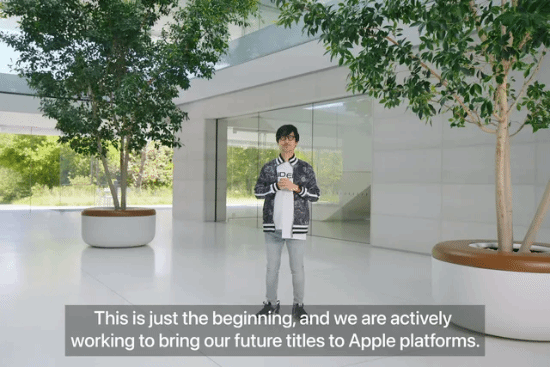
The WWDC23 conference even invited the well-known game producer Hideo Kojima to the platform, announcing that “Death Stranding Director’s Cut” will launch a macOS version in the near future, which further proves that Apple wants to continue to deeply cultivate the 3A game market. Determination, as a dual-identity user of a gamer and a Mac user, you should be very happy and excited. Let us continue to look forward to more 3A masterpieces landing on the Mac platform.
Conclusion: Vision Pro sees the future, Mac focuses on the present
The emergence of Vision Pro is indeed exciting, which means that Apple, which is steadily advancing, has also begun to promote the next-generation computing platform. Although in some respects, the limitations of current technology can still be seen, but in terms of interaction and audio-visual effects, Vision Pro has shown a very high degree of completion, and although the price starts at $3499, it is still very exciting.
Compared with such epoch-making devices as the Vision Pro, although the new Mac products are not so dazzling, they are gradually making up for the shortcomings of the past, completing the product line layout of the M chip, and saying goodbye to the Intel chip. The game mode of macOS also means that Apple’s We are working hard to make “Mac platform can’t play games” a thing of the past.
Whether Apple can continue to rule the next era of computing with Vision Pro, let us wait and see.
[ad_2]
Source link








